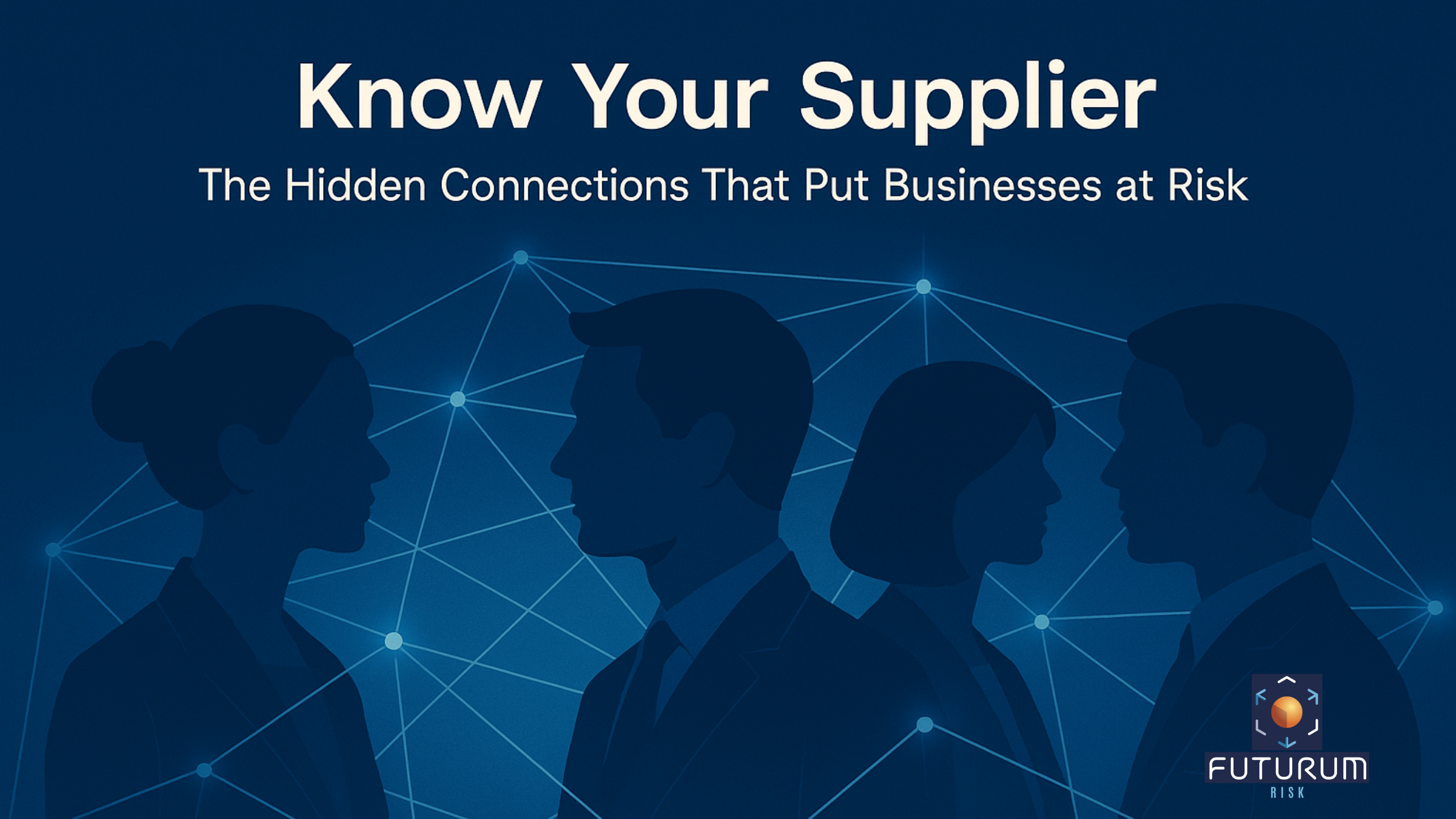Every company relies on suppliers. They help you grow, reduce costs, and reach new markets. They also open the door to risks you may never see until it is too late. A supplier that looks trustworthy on paper can still pull you into sanctions, fraud, or reputational crises.
The idea of “Know Your Supplier” is not new, but in today’s environment, it has never mattered more. Global trade routes shift under political pressure. AI tools make fake paperwork look authentic. Social media can turn one quiet incident into an international story. When the spotlight moves onto a company, partners get caught up in the consequences, whether they were directly involved or not.
Your supply chain is not only about efficiency. It is also about exposure. And the harsh reality is that your company is only as resilient as the weakest link in that chain.
A Case in Point
One recent case we investigated shows how quickly things can unravel. A logistics firm in a respected financial centre had long-standing clients and clean compliance paperwork. On the surface, it looked safe. The trouble started when journalists and regulators discovered the firm had been moving modules for a project tied to restricted entities.
The firm insisted it had done nothing wrong and that its shipments were routine. That did not matter. Once the firm was placed under sanctions, the fallout spread quickly. Banks froze payments. Insurance was cancelled. Partners in other countries disengaged out of fear of secondary exposure. Even companies that had never been named in the investigation faced delays, frozen receivables, and pressure from their own clients to prove they had vetted every link in their chain.
Our client in this matter was never accused of wrongdoing. They had complied with all the laws in their own jurisdiction. Yet they still suffered the consequences because of a supplier’s hidden exposure. It was a stark reminder that risk spreads faster than contracts can protect you.
Why Supplier Risk Has Changed
Supply chain risk has always existed, but three forces make it far more dangerous today.
1. Geopolitical instability
Conflicts and sanctions now reach across industries and borders. A company may think it is insulated because it does not operate in a sanctioned country. Yet if a supplier works with entities in restricted regions, that link can taint the entire chain. The impact is immediate: frozen payments, cancelled insurance, or regulatory scrutiny.
What makes this worse is the speed of enforcement. Sanctions used to take months to filter through. Now updates happen overnight, and the expectation is that businesses adapt just as quickly. Being caught even briefly on the wrong side of a changing list can lock up your contracts and cash flow.
2. Technology misuse
Generative AI is a gift to fraudsters. Fake invoices, forged certificates, and synthetic identities can pass a quick review. Entire “phantom suppliers” can be created with convincing websites, fabricated staff profiles, and copied compliance documents. What once required months of effort by organised crime can now be created in hours by a small team with a laptop.
This technology arms fraudsters with a dangerous advantage. Companies relying only on paperwork or automated screening will miss these risks until money has already left their accounts.
3. Public perception
The court of public opinion has become as powerful as any regulator. A resurfaced news story, a leaked email, or a viral video can reshape how a supplier is viewed overnight. Once the narrative turns negative, banks and insurers often react first. They reduce exposure, freeze accounts, or cancel policies. Legal processes may take months, but reputational damage spreads instantly.
Together, these forces mean the old way of doing due diligence, ticking boxes and filing certificates, no longer protects companies. Leaders need to understand not only who a supplier is, but who they are connected to, how they operate, and how they are perceived.
The Real Cost of Blind Spots
The financial cost of supplier risk is easy to measure. The hidden costs are just as damaging.
Picture a shipment worth millions sitting at a port. You have met all your obligations. Yet customs holds the cargo because a subcontractor in the chain is linked to a restricted entity. Every day that the shipment sits idle costs money, frustrates customers, and erodes confidence.
Now, picture your finance team trying to explain to your bank why a regular payment has been frozen. The bank has seen headlines about your supplier. They are not interested in the fine details of compliance. They want reassurance that your company will not drag them into controversy. Until you can prove that, the credit line remains closed.
The human cost is just as real. Senior leaders face questions from investors and the board. Staff who worked on the contract worry about their own reputations. The legal team scrambles to review exposure while procurement rushes to find new partners under pressure. What began as a single weak link in the chain now feels like a fire burning across the business.
Blind spots do not just create compliance headaches. They drain resources, damage trust, and leave leaders reacting instead of controlling. This is why supplier risk must be treated as a frontline issue, not a background task.
What Companies Should Aim For
No company can predict every risk. But leaders can create a culture where supplier due diligence is more than paperwork. At its core, it comes down to three principles:
Clarity on control
Ownership on paper is only part of the story. Who truly controls the company? Who can block decisions, steer strategy, or shift assets? Influence often hides behind holding vehicles, family ties, or golden shares. Clarity on control keeps surprises out of your boardroom.
Visibility on end use
It is not enough to know what you sell. You must know where it ends up and how it will be used. A product that seems ordinary can become sensitive once deployed in certain projects or regions. Banks and regulators focus on end use as much as they do on ownership. That means you should, too.
Flexibility to walk away
Contracts matter, but trust matters more. If new information comes to light, you need the right to disengage quickly. That flexibility protects your reputation and reassures your partners that you will not drag them into a mess.
A Practical Checklist for Leaders
Boards and executives often need a simple framework to make quick decisions. These five questions help test supplier resilience:
- Who really controls this supplier? Ownership charts are not enough. Look for golden shares, veto rights, family influence, or offshore holding companies that mask true control.
- Who are the end users? It is not just about what you sell. It is about where it ends up and how it is used. A product that looks harmless on paper can become highly sensitive in the wrong project.
- What story do the routes tell? Repeated detours through free zones or high-risk jurisdictions can turn neutral transactions into red flags. Patterns matter more than isolated events.
- Can subcontractors change your risk? Many deals involve unseen subcontractors. If they are not vetted, they can expose you without notice.
- How is this supplier perceived? Reputation is now part of compliance. A spike in negative coverage can shut down banking and insurance relationships, even if the law still allows the trade.
If leaders can answer these five questions, they are far better prepared to keep risk under control.
The Bigger Picture
Supplier risk is not only about avoiding penalties. It is about positioning your company as a trustworthy partner. Customers and banks want to see evidence that you take risk seriously. Insurers want confidence that you will not expose them to surprise claims. Investors want proof that governance is more than a slogan.
A company that demonstrates rigorous supplier oversight does more than comply. It attracts stronger partners, secures better contracts, and builds resilience in a volatile market. That resilience becomes a competitive edge.
It is worth remembering that many sanctions cases never involve a company directly. They involve partners, subcontractors, or affiliates. Yet the fallout spreads to anyone nearby. The company that can show it has mapped its supply chain, tested its assumptions, and monitored its risks will be the one that keeps trading when others grind to a halt.
How Futurum Risk Helps
At Futurum Risk, we specialise in uncovering the links that others miss. Our supplier and third-party due diligence combines corporate records, sanctions databases, open-source intelligence, and advanced digital monitoring. We map ownership, track control, analyse media sentiment, and identify exposure to restricted jurisdictions.
The goal is not to overwhelm clients with data. It is to provide clear answers: Who really controls this company? Who are they connected to? Where does the product end up? What are the reputational signals around them? We deliver those answers in a way that boards, banks, and customers can understand.
By doing this work early, our clients avoid sudden shocks that damage contracts and reputations. They gain credibility with partners, reassurance with regulators, and the confidence to make decisions quickly.
What It All Comes Down To
Trusting suppliers is necessary for growth. Trusting without verifying is a gamble. In the current environment, one hidden connection can bring down contracts, freeze payments, and put reputations at risk.
Knowing your supplier is not just good practice. It is survival. And the companies that invest in visibility, clarity, and control today will be the ones still standing tomorrow.





